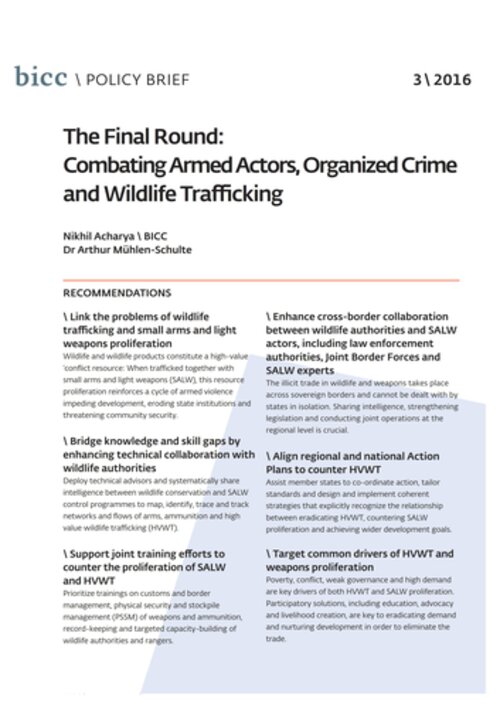Publications
The final round: Combating armed actors, organized crime and wildlife trafficking
Release Date
2016-06
Language
- English
Topics
- –
This policy brief aims to equip SALW policymakers and practitioners with an understanding of how increased wide-scale wildlife trafficking is directly linked to the involvement of organized crime, heavily armed state and non-state actors and the proliferation of small arms, light weapons and ammunition, creating a volatile mix that threatens cross-border destabilization and causes insecurity. The brief argues that the SALW control community of practice, including donors, policymakers, practitioners and national authorities, should closely collaborate with the conservation community, underlining potential areas of co-operation. Further, it offers recommendations on how regional and sub-regional organizations can play an instrumental role in facilitating the prevention of wildlife trafficking.
The authors recommend:
\ Link the problems of wildlife trafficking and small arms and light weapons (SALW) proliferation.
Wildlife and wildlife products constitute a high-value ‘conflict resource’: When trafficked together with small arms and light weapons (SALW), this resource proliferation reinforces a cycle of armed violence impeding development, eroding state institutions and threatening community security.
\ Bridge knowledge and skill gaps by enhancing technical collaboration with wildlife authorities.
Deploy Technical Advisors and systematically share intelligence between wildlife conservation and SALW control programmes to map, identify, trace and track networks and flows of arms, ammunition and high value wildlife trafficking (HVWT).
\ Support joint training efforts to counter proliferation of SALW and HVWT.
Prioritize trainings on customs and border management, physical security and stockpile management (PSSM) of weapons and ammunition, record-keeping and targeted capacity-building of wildlife authorities and rangers.
\ Enhance cross-border collaboration between wildlife authorities and SALW actors, including law enforcement authorities, Joint Border Forces, SALW experts.
Illicit trade in wildlife and weapons takes place across sovereign borders and cannot be dealt with by states in isolation. Sharing intelligence, strengthening legislation and conducting joint operations at the regional level is crucial.
\ Align regional and national Action Plans to counter HVWT.
Assist member states to co-ordinate action, tailor standards and design and implement coherent strategies that explicitly recognize the relationship between eradicating HVWT, countering SALW proliferation and achieving wider development goals.
\ Target common drivers of HVWT and weapons proliferation.
Poverty, conflict, weak governance and high demand are key drivers of both HVWT and SALW proliferation. Participatory solutions, including education, advocacy and livelihood creation, are key to eradicating demand and nurturing development in order to eliminate the trade.
PDF-Download
policy_brief_3_2016.pdf
[English] (161.89 KB)

Cite as
@techreport{AcharyaMuhlen-Schulte2016,
author = "Nikhil Acharya and Arthur Mühlen-Schulte",
title = "The final round: Combating armed actors, organized crime and wildlife trafficking",
latexTitle = "The final round: Combating armed actors, organized crime and wildlife trafficking",
publisher = "BICC",
number = "3",
institution = "BICC",
type = "BICC Policy brief",
year = "2016",
address = "Bonn",
}
Document-Type
BICC Policy brief
Publisher
BICC
Place
Bonn



